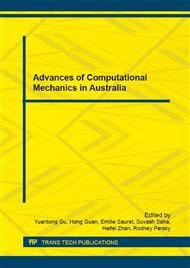[1]
P. Van den Berg, Analysis of soil penetration. Ph.D. thesis, Technische Universiteit Delft, (1994).
Google Scholar
[2]
Y. Hu, M.F. Randolph, A practical numerical approach forlarge deformation problems in soils. Int J Numer Anal MethodsGeomech 22 (1998), 327–350.
DOI: 10.1002/(sici)1096-9853(199805)22:5<327::aid-nag920>3.0.co;2-x
Google Scholar
[3]
M. Nazem, D. Sheng, J.P. Carter, Stress integration and mesh refinement in numerical solutions to large deformations in geomechanics, Int. J. Numer. Methods Engng 65 (2006), No. 7, 1002– 1027.
DOI: 10.1002/nme.1470
Google Scholar
[4]
C. Farhat, C. Degand, B. Koobus, M. Lesoinne, Torsional springs for two dimensional dynamic unstructured fluid meshes, Comput Methods Appl Mech Eng. 163 (1998), 231–245.
DOI: 10.1016/s0045-7825(98)00016-4
Google Scholar
[5]
A. De Boer, M.S. Van der Schoot, H. Bijl, Mesh deformation based on radial basis function interpolation, Comput. & Struct. 85 (2007), 784–795.
DOI: 10.1016/j.compstruc.2007.01.013
Google Scholar
[6]
V. Vavourakis, D. Loukidis, D.C. Charmpis, P. Papanastasiou, Assessment of remeshing and remapping strategies for large deformation elastoplastic Finite Element analysis, Comput. & Struct. 114-115 (2013), 133-146.
DOI: 10.1016/j.compstruc.2012.09.010
Google Scholar
[7]
J.A. Cottrell, T.J.R. Hughes, Y. Bazilevs, Isogeometric Analysis. A John Wiley and Sons, Ltd, Publication, (2009).
Google Scholar
[8]
P.M. Knupp, Algebraic mesh quality metrics for unstructured initial meshes, Finite Elements in Analysis and Design. 39 (2003), 217-241.
DOI: 10.1016/s0168-874x(02)00070-7
Google Scholar
[9]
P.P. Pebay, T.J. Baker, Analysis of triangle quality measures, Mathematics of Computation. 72 (2003), No. 244, 1817-1839.
Google Scholar
[10]
M. Nazem, J.P. Carter, Parametric study of a free-falling penetrometer in clay-like soils, Frontiers in Offshore Geotechnics II – Gourvenec & White (eds) Taylor & Francis Group, London, (2011).
DOI: 10.1201/b10132-30
Google Scholar
[11]
M.H. Moavenian, M. Nazem, J.P. Carter, M.F. Randolph, Numerical analysis of penetrometers free-falling into soil with shear strength increasing linearly with depth, Comp & Geotech. 2015, (under review).
DOI: 10.1016/j.compgeo.2015.11.002
Google Scholar
[12]
J.P. Carter, M. Nazem, D.W. Airey, Analysis of dynamic loading and penetration of soils applications to site investigation and ground improvement, International Conference on Geotechnical Engineering, 2013, pp.65-91.
Google Scholar


